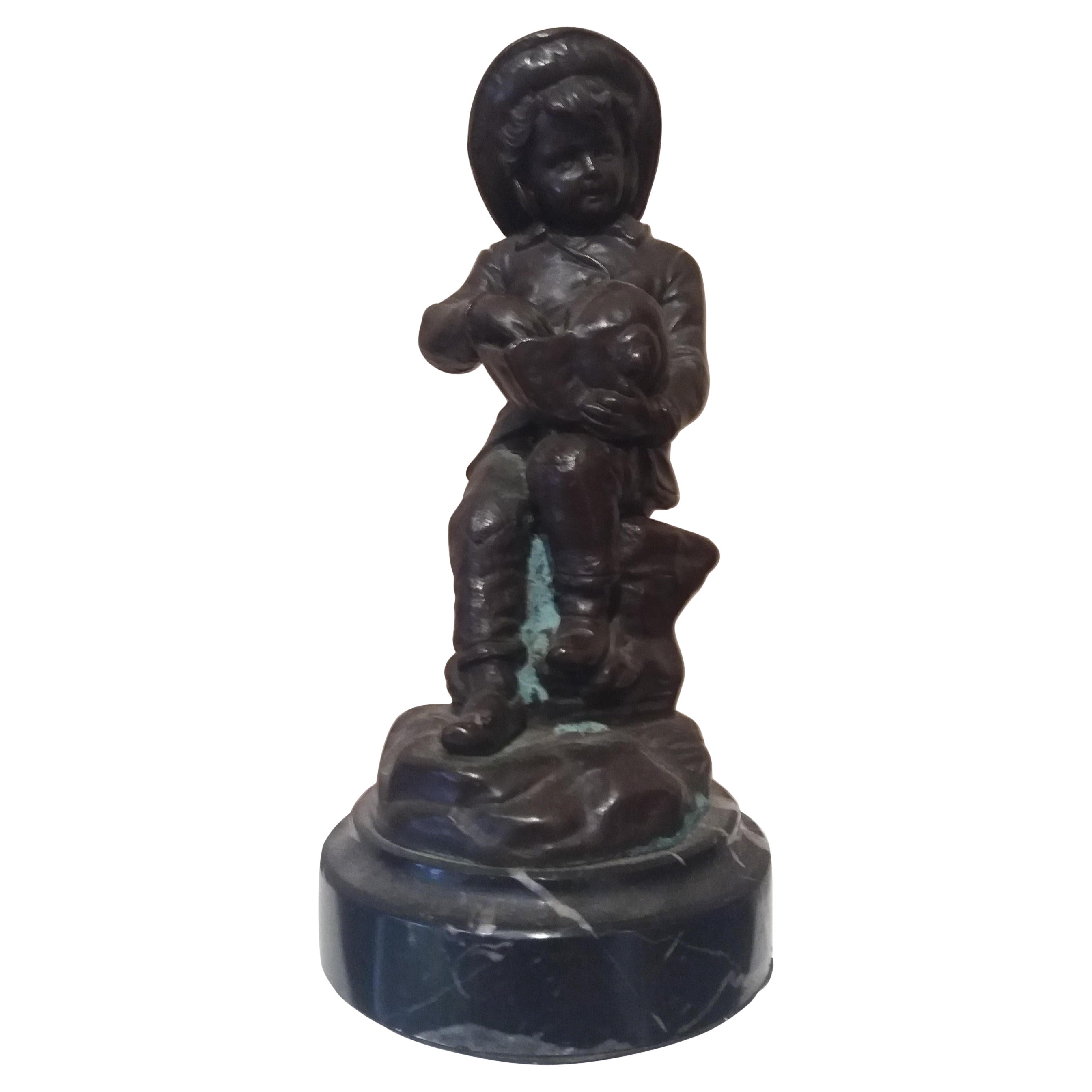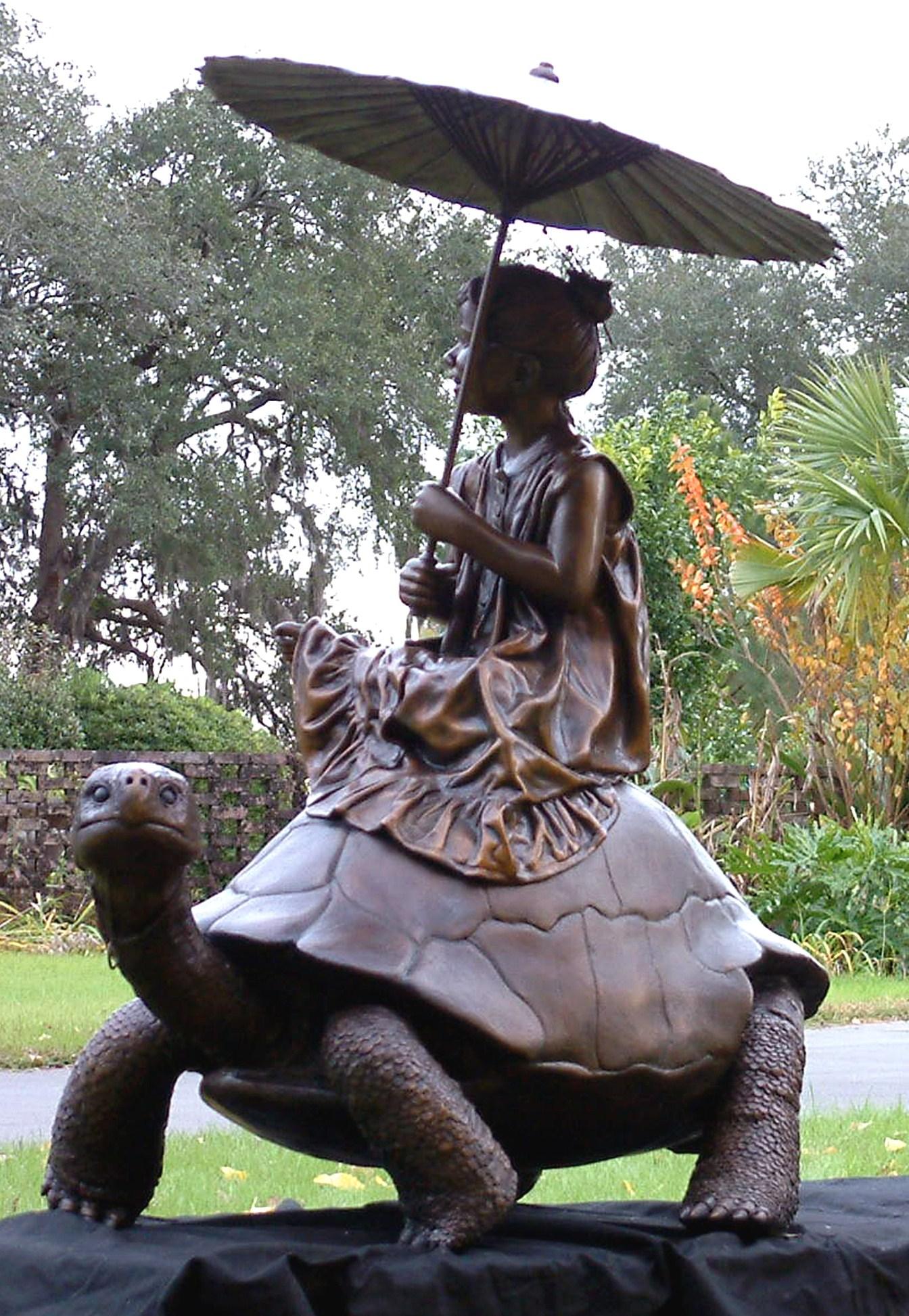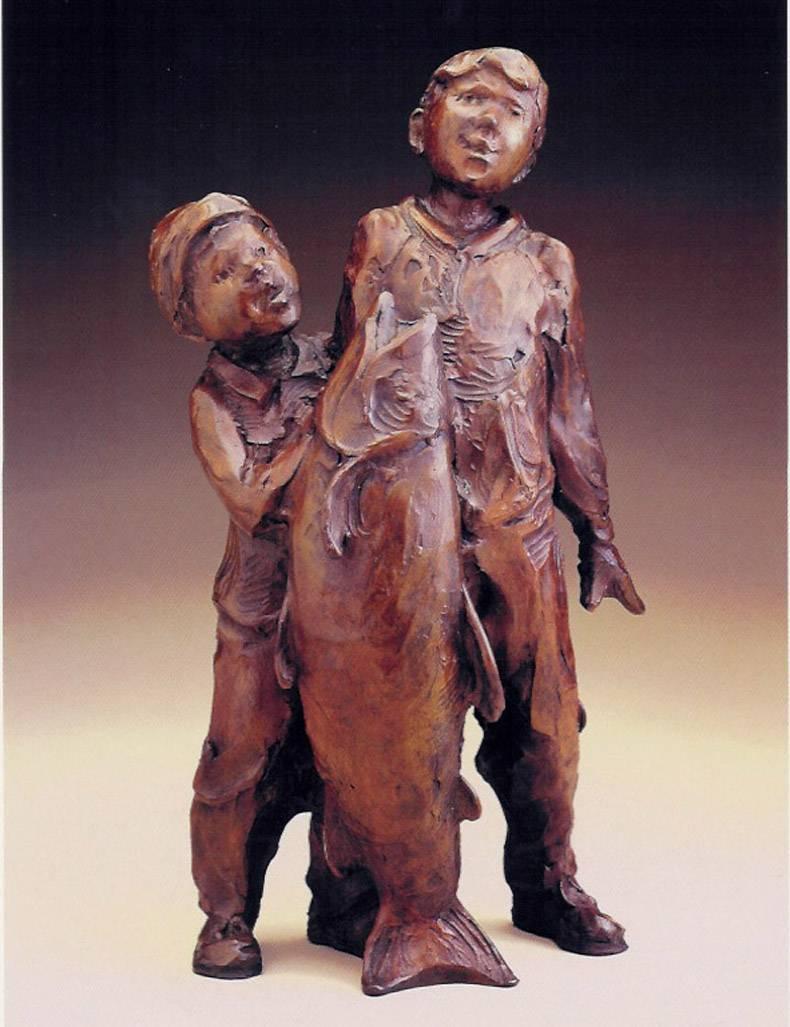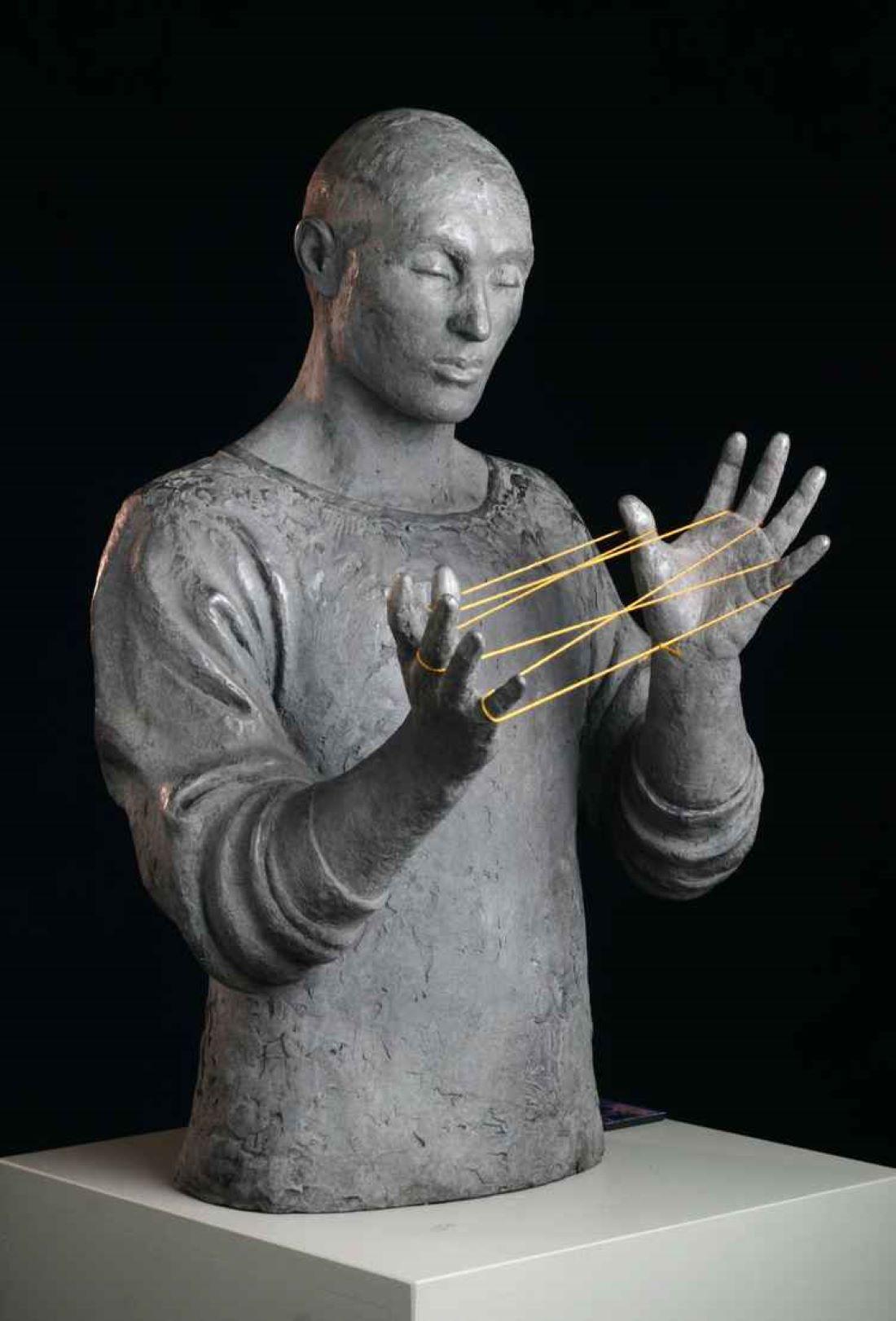Carl KaubaNative American in Canoec. 1920
c. 1920
About the Item
- Creator:Carl Kauba (1865 - 1922, Austrian)
- Creation Year:c. 1920
- Dimensions:Height: 5.5 in (13.97 cm)Width: 10 in (25.4 cm)Depth: 2.75 in (6.99 cm)
- Medium:
- Movement & Style:
- Period:
- Condition:
- Gallery Location:Missouri, MO
- Reference Number:1stDibs: LU74733374281
Carl Kauba
Austrian sculptor Carl Kauba was fascinated by the American West, creating dynamic cast bronze sculptures of cowboys, Native Americans and buffalo. Between 1895 and 1912, his polychrome pieces captured the attention of an American audience, while his domestic statutory work in Austria helped solidify his artistic reputation.
He was born the son of a shoemaker in 1865 in Vienna, Austria. He later studied at the Academy of Fine Arts in Vienna before learning from sculptor Karl Waschmann and sculptor and medallist Stefan Schwartz.
Although some accounts have Kauba traveling to the United States to create models and sketches, scholars have questioned the inaccuracies in his work’s weapon detailing and equestrian costumes. Kauba loved the Western tales of German author Karl May and was known to have a friend in Ohio who mailed him costume material, all of which may have provided his references for art.
Kauba’s bronze work is recognized as exceptional Viennese craftsmanship imbued with artistic intricacies and realism. His sculptures of cavalrymen, cowboys and Indigenous people from the American West put him in the same category as titans of American Western art like Frederic Remington and Charles Marion Russell.
Original Carl Kauba art experienced a resurgence in popularity during a 1950s advertising campaign for Latendorfer in New York. His works have remained prized by Wild West collectors everywhere.
Kauba’s art has been exhibited at many American art galleries, including the Thomas Nygard Gallery in Montana and the Ophir Gallery in New Jersey.
On 1stDibs, find a collection of Carl Kauba decorative objects, collectibles and more.
- ShippingRetrieving quote...Ships From: Missouri, MO
- Return PolicyA return for this item may be initiated within 2 days of delivery.
- Study AimBy Carl KaubaLocated in Missouri, MOCarl Kauba "Study Aim" c. 1920 Bronze with Brown Patina Signed approx. 9.5 x 10 x 4 This Austrian sculptor was born in Vienna in 1865. His teachers were Karl Waschmann (1848-1905), known for his ivory sculptures and portrait plaquettes of contemporary celebrities, and Stefan Schwartz (1851-1924), who exhibited in Paris, including the Exposition Universelle of 1900 where he won a gold medal. Kauba's intricate bronzes, imported to the United States between 1895 and 1912, were cast at the Roman Bronze Works. Kauba was part of the nineteenth-century tradition of polychrome bronze sculpture. There were several types of patinas on a single statue: he could render the color of buckskin, variously tinted shirts, blankets, feathers, as well as beaded moccasins. Reportedly, Kauba came to America around 1886. Inspired by the Western tales of German author Karl May, he traveled to the West and made sketches and models. Critics, however, pointed out inaccuracies of costume and other details. For instance, the guns that his "mid-nineteenth-century" figures use are models produced after 1898. Apparently he did all of his works back in Vienna. Besides the variety of color, Kauba's bronzes show a great range of textures and his style is highly naturalistic. The sculptor loved ornament, some of which he rendered with coiled wire for reins, rope and feathers in headdresses. He successfully rendered figures in motion and often executed compositions with more than one figure. Berman (1974) illustrates non-Western subjects by Kaula, such as the pendants Where? and There (ca. 1910), a seated Scottish couple, impressive in the expressions and the details on patterned fabrics of both sitters. Another genre piece is Buster Brown...Category
Early 20th Century Realist Figurative Sculptures
MaterialsBronze
- Going into BattleBy Carl KaubaLocated in Missouri, MOCarl Kauba "Going into Battle" c. 1920s Bronze with Brown Patina Signed approx 10 x 10 x 4 (including wooden base) This Austrian sculptor was born in Vienna in 1865. His teachers were Karl Waschmann (1848-1905), known for his ivory sculptures and portrait plaquettes of contemporary celebrities, and Stefan Schwartz (1851-1924), who exhibited in Paris, including the Exposition Universelle of 1900 where he won a gold medal. Kauba's intricate bronzes, imported to the United States between 1895 and 1912, were cast at the Roman Bronze Works. Kauba was part of the nineteenth-century tradition of polychrome bronze sculpture. There were several types of patinas on a single statue: he could render the color of buckskin, variously tinted shirts, blankets, feathers, as well as beaded moccasins. Reportedly, Kauba came to America around 1886. Inspired by the Western tales of German author Karl May, he traveled to the West and made sketches and models. Critics, however, pointed out inaccuracies of costume and other details. For instance, the guns that his "mid-nineteenth-century" figures use are models produced after 1898. Apparently he did all of his works back in Vienna. Besides the variety of color, Kauba's bronzes show a great range of textures and his style is highly naturalistic. The sculptor loved ornament, some of which he rendered with coiled wire for reins, rope and feathers in headdresses. He successfully rendered figures in motion and often executed compositions with more than one figure. Berman (1974) illustrates non-Western subjects by Kaula, such as the pendants Where? and There (ca. 1910), a seated Scottish couple, impressive in the expressions and the details on patterned fabrics of both sitters. Another genre piece is Buster Brown...Category
Early 20th Century Realist Figurative Sculptures
MaterialsBronze
- The Hunter and HoundBy Pierre Jules MêneLocated in Missouri, MOPierre-Jules Mene "The Hunter and Hound" (Le Valet de Limier) 1879 Bronze approx. 19 x 8 x 14 inches Signed PIERRE JULES MENE (1810-1879) Pierre...Category
1870s Realist Figurative Sculptures
MaterialsBronze
- Lion and Antelope (No. 23)Located in Missouri, MOAlfred Barye (1839-1882) "Lion and Antelope" Bronze Approx. 7.5H x 9W x 4D inches Signed "BARYE.ALF" and Inscribed under base "NO. 23 LION AND ANTELOPE" The son of a goldsmith, Parisian born Antoine-Louis Bayre was a sculptor of animal subjects and acclaimed, not only for his apparent skill, but as the founder of what became known as the French Animaliers School. Among his patrons were representatives of the state government and royalty including the Duke of Orleans and the Dukes of Luynes, Montpensier and Nemours. Well compensated financially, he was able to buy the best of materials and hire the country's most skilled foundry craftsmen. The foundry he hired was owned by Ferdinand Barbedienne, and casts from this period were stamped with the letters, FB. However, he did not make a lot of money from his work because he was such a perfectionist that often he would not sell his work because he thought it was not 'quite right'. In 1848, he declared bankruptcy, and his molds and plaster casts were sold along with the copyrights. Bayre's specialty was aroused, angry seeming wild game such as lions and tigers and elephants, but he also did equestrian groups and mythology figures. In order to do realistic depictions of animal anatomy, he spent much time at the Jardin de Plantes in Paris. His early training was as an apprentice to a metal engraver, but being drafted in the army in 1812, ended that education. In 1832, he had established his own studio, and unique at that time was his method of cold stamping his bronze casts, so that each one had a special number. He had his first entry, The Milo of Croton...Category
19th Century Realist Figurative Sculptures
MaterialsBronze
- Jockey On HorsebackBy Hans GuradzeLocated in Missouri, MOHans Guradze (German, 1861-1922) "Jockey On Horseback" Bronze Approx. 19.5 x 17 x 6 inches Signed "H. Guradze Berlin" on BaseCategory
1890s Realist Figurative Sculptures
MaterialsBronze
- Mountain GoatBy Jules MoigniezLocated in Missouri, MOJules Moigniez "Mountain Goat" Bronze approx 11 x 9 x 4 inches Signed Jules Moigniez (1835-1894) Jules Moigniez was born in Senlis sur L'Oise, France ...Category
1870s Realist Figurative Sculptures
MaterialsBronze
- Bollel Child and conch shell. Original multiple bronze sculptureLocated in CORAL GABLES - MIAMI, FLBOLLEL. Child and conch shell. Original multiple bronze sculptureCategory
1980s Realist Figurative Sculptures
MaterialsBronze
- TURTLE TRAINBy W Stanley ProctorLocated in Tallahassee, FLLife size child on life size tortoise. Combination of young child's imagination and reality.Category
21st Century and Contemporary Realist Figurative Sculptures
MaterialsBronze
- "On the Wings of an Eagle", Chester Fields, Bronze and Steel Sculpture, 54x40x24By Chester FieldsLocated in Dallas, TX"On the Wings of an Eagle by Chester Fields is one of his most popular sculptures. This is number 26 of 75 made. It is made with the following: Bronze Casting Deluxe Patina Gold Beak...Category
1990s Realist Figurative Sculptures
MaterialsBronze, Stainless Steel
- Antique Dog: Bulldog Playing with a Mouse- Henri Émile Adrien Trodoux ca. 1870sLocated in SANTA FE, NMAntique Bronze Dog Bulldog Playing with a Mouse on Sheaves of Wheat Henri Émile Adrien Trodoux (1815-1881) 6 1/8 x 3 7/5 inches Signed on the terrace Henri Émile Adrien Trodoux (Fre...Category
Mid-19th Century Realist Figurative Sculptures
MaterialsBronze
- Big Fish StoryBy Jane DeDeckerLocated in Greenwich, CTSculpture of two boys displaying a sizeable catch.Category
1990s Realist Figurative Sculptures
MaterialsBronze
- Cat's CradleBy Bill StarkeLocated in Denver, CO"Cat's Cradle" is a limited edition sculpture created by Bill Starke depicting a figure playing with string. About the artist: Human beings interacting, colliding, cooperating, striving, & achieving are the themes I wish to portray in my sculptures. My observations on the human condition are meant to be both humorous and thought provoking. Bill Starke's "Free Man" is everything that good art should be: technically superb, brilliantly composed, emotionally powerful and visually arresting... like George Stubbs, the 18th century English master...Category
2010s Realist Figurative Sculptures
MaterialsBronze






